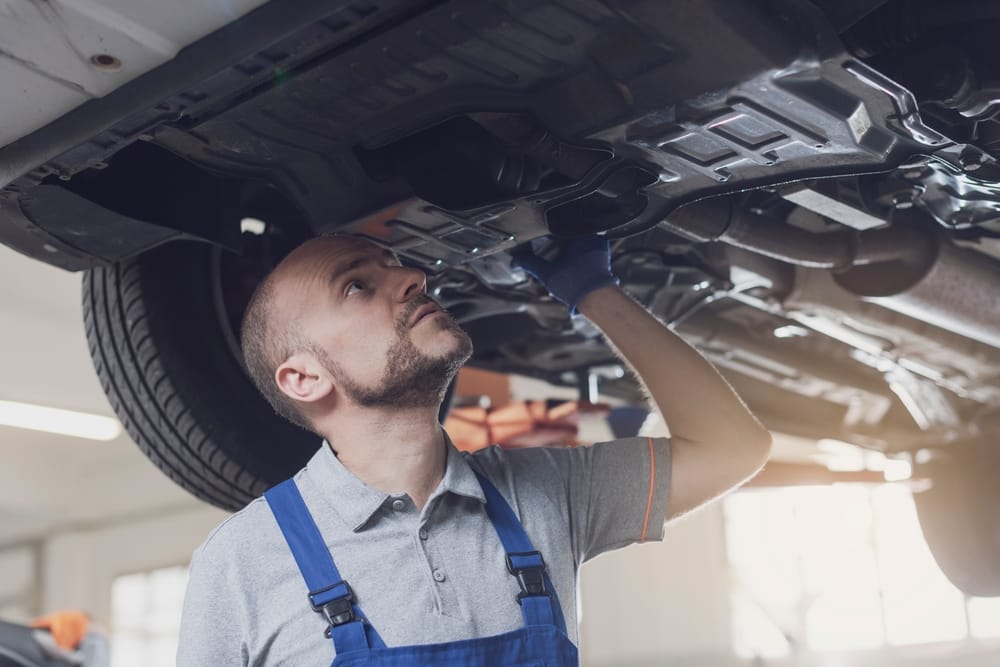No products in the cart.


Ever heard that awful clunking sound when you step on the accelerator?
Don’t worry, you’re not the only one! It’s a pretty common issue for car owners, and more often than not, the culprit is hiding beneath your car in the form of a worn-out tailshaft.
Let’s start with the basics. The tailshaft (or driveshaft as some call it) is that long, spinning tube connecting your gearbox to the diff.
Its job is to transfer power from the engine to the wheels, which allows the car to move.
Now, these things handle a fair bit of stress, especially if you love a bit of spirited driving. Over time, these parts can wear out, leading to those nasty clunking noises.
There are a few reasons why your tailshaft might be making a racket. One of the most common is worn-out universal joints (U-joints for short). These little guys are like the elbows of your tailshaft, allowing it to bend and flex as you drive. When they get worn, they can create a clunking or clanging sound, especially when you accelerate or change gears.
Another common issue is a worn-out centre bearing. This bearing supports the middle of the tailshaft and helps keep it stable. If it’s on the way out, you might hear a knocking or thumping sound, particularly when you’re accelerating or decelerating.
Lastly, there is the possibility of a bent or damaged tailshaft. This can happen if you’ve hit a curb, bottomed out on a speed bump, or been involved in an accident. A bent tailshaft can cause all sorts of unpleasant vibrations and noises.
We understand that car problems can be a real pain, and it’s tempting to just ignore them and hope they go away. But trust us, when it comes to your tailshaft, ignoring the problem is only going to make things worse.
A damaged tailshaft can cause serious vibrations, which can lead to further damage to your car’s driveline and suspension. In extreme cases, it could even lead to a complete car failure, leaving you stranded on the side of the road.
So, what’s the solution?
If you’re hearing any strange noises coming from your car, the best thing to do is get it checked out by a qualified mechanic. They’ll be able to diagnose the problem and recommend the best course of action, whether it’s a simple repair or a complete tailshaft replacement.
If you’re in Melbourne and need expert advice on your tailshaft, GJ Drivelines is the place for you! We specialise in all things tailshafts, from repairs and reconditioning to custom manufacturing and high-speed balancing.
Contact our team at GJ Drivelines today and we’ll get your car running smoothly in no time, so you can get back to enjoying the open road.
Ever heard that awful clunking sound when you step on the accelerator?
Don’t worry, you’re not the only one! It’s a pretty common issue for car owners, and more often than not, the culprit is hiding beneath your car in the form of a worn-out tailshaft.
Let’s start with the basics. The tailshaft (or driveshaft as some call it) is that long, spinning tube connecting your gearbox to the diff.
Its job is to transfer power from the engine to the wheels, which allows the car to move.
Now, these things handle a fair bit of stress, especially if you love a bit of spirited driving. Over time, these parts can wear out, leading to those nasty clunking noises.
There are a few reasons why your tailshaft might be making a racket. One of the most common is worn-out universal joints (U-joints for short). These little guys are like the elbows of your tailshaft, allowing it to bend and flex as you drive. When they get worn, they can create a clunking or clanging sound, especially when you accelerate or change gears.
Another common issue is a worn-out centre bearing. This bearing supports the middle of the tailshaft and helps keep it stable. If it’s on the way out, you might hear a knocking or thumping sound, particularly when you’re accelerating or decelerating.
Lastly, there is the possibility of a bent or damaged tailshaft. This can happen if you’ve hit a curb, bottomed out on a speed bump, or been involved in an accident. A bent tailshaft can cause all sorts of unpleasant vibrations and noises.
We understand that car problems can be a real pain, and it’s tempting to just ignore them and hope they go away. But trust us, when it comes to your tailshaft, ignoring the problem is only going to make things worse.
A damaged tailshaft can cause serious vibrations, which can lead to further damage to your car’s driveline and suspension. In extreme cases, it could even lead to a complete car failure, leaving you stranded on the side of the road.
So, what’s the solution?
If you’re hearing any strange noises coming from your car, the best thing to do is get it checked out by a qualified mechanic. They’ll be able to diagnose the problem and recommend the best course of action, whether it’s a simple repair or a complete tailshaft replacement.
If you’re in Melbourne and need expert advice on your tailshaft, GJ Drivelines is the place for you! We specialise in all things tailshafts, from repairs and reconditioning to custom manufacturing and high-speed balancing.
Contact our team at GJ Drivelines today and we’ll get your car running smoothly in no time, so you can get back to enjoying the open road.
Chrysler – Dodge
727 – 30 Spline 1 11/16″ Seal Diameter
904 – 26 Spline 1 9/16″ Seal Diameter
Ford
C6-T56 – 31 Spline 1 11/16″ Seal Diameter
AOD & C4 & T5 – 28 Spline 1 1/2″ Seal Diameter
4 R 7OW – 28 Spline 1.598″ Seal Diameter
General Motors
T-350 700R4-4LLOE – 27 Spline 1 1/2″ Seal Diameter
T-400-4L80E – 32 Spline 1 7/8″ Seal Diameter
Note: Transmission slip yokes are manufactured with various U-Joint Series. It is important to match Horsepower and Torque requirements to U-Joint Series. For aftermarket transmission applications usually a spline count and seal diameter will identify slip yoke required.

If Pinion Yoke has Placement tabs that retain the U-Joint, measure inside tabs. See Diagram D.

If Pinion Yoke does not have Placement Tabs that retain U-Joint, measure from flat of yoke inside to inside. See Diagram E.

If 4 bolt Flange is used on pinion, measure Pilot Diameter and center to center diagonally bolt hole to bolt hole. See Diagram L.

Universal Joint Size. There are hundreds of U-Joint sizes or “Series” to accomodate many different applications of power and desired longevity for your automotive, 4×4 truck or auto racing requirements, these 4 series of joints cover most needs.
1310 Spicer Series: 1 1/16″ Cup Diameter (Dim C – Diagram A) 3 7/32″ length (Dim B – Diagram A) Certain Ford applications have 2 cups 1 1/8 Diameter. Appropriate horse power range is up to 500 in circle track or road racing, small tire drag racing and 4×4. Also available: Performance Dynamic Cryo Joint.
1330 Spicer Series: 1 1/16″ Cup Diameter (Dim C – Diagram A) 3 5/8″ length (Dim B – Diagram A) Certain Ford applications have 2 cups 1 1/8 Diameter. Slightly stronger than 1310, Used in 5.0 Mustangs. Also available: Performance Dynamic Cryo Joint.
3R Saginaw Series: 1 1/8″ Cup Diameter (Dim C – Diagram A) Retained with internal clip 2 5/8″ (Dim B – Diagram A). Most common GM joint. Horse power range up to 700 in road racing and circle track. Solid drag racing U-Joint can accomodate most sportsman classes. Also available: Performance Dynamic Cryo Joint.
1350 Spicer Series: Manufactured with OEM tolerances and treated with our Cryogenic Process to yeild the strongest U-Joint available. For drag racing applications a solid non-lube design U-Joint is recommended because of the tremendous initial shock load, or short duration of high torque the joint must be able to withstand.

If PST is supplying you with transmission slip yoke, Pinion yoke and driveshaft yoke measure Dim W. See Diagram N.
If PST is supplying you with transmission slip yoke and driveshaft measure Dim X. See Diagram N.
2 Piece driveshafts use Dim Y + Z. See Diagram N.